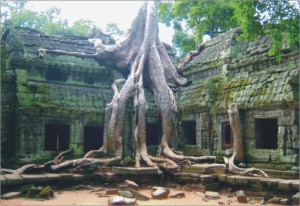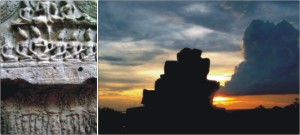| Travelogue
In the land of Angkor..
Tasmia Khan
 Looking at my green passport, the immigration officer paused for a while and then there was a sudden hastiness in their pace and a lot of bizarre whispering went on. “Expected”, I thought, as I looked at my friends waiting for me patiently at the small arrival hall of Siem Reap International airport. They understood the situation well enough by then as I had gone for many backpacking trips with them before. After about 10minutes we were all cleared and stepped out of the airport where a small van was waiting for us to take us to Villa Siem Reap. Cambodia welcomed us with a drizzling morning, narrow roads, paddy fields, a huge smile from the hostel boy and an enormous excitement from the anticipation of the exploration of its magical ruins. Looking at my green passport, the immigration officer paused for a while and then there was a sudden hastiness in their pace and a lot of bizarre whispering went on. “Expected”, I thought, as I looked at my friends waiting for me patiently at the small arrival hall of Siem Reap International airport. They understood the situation well enough by then as I had gone for many backpacking trips with them before. After about 10minutes we were all cleared and stepped out of the airport where a small van was waiting for us to take us to Villa Siem Reap. Cambodia welcomed us with a drizzling morning, narrow roads, paddy fields, a huge smile from the hostel boy and an enormous excitement from the anticipation of the exploration of its magical ruins.
Siem Reap is a small province in the North-west of Cambodia where the ancient ruins stand stark while the Great Tonle Sap Lake runs by. Once a cluster of quiet villages has turned into a major tourist spot as one would say, the lifestyle looks still as laid back and buttoned up. If you are dilly-dallying your time over the issue of landmines, I must assure you that living in Dhaka can be and is far more dangerous.
Our first day was not much eventful and we took the opportunity to explore the town keenly. The hostel we were living at was called Villa Siem Reap and was owned and managed by an Australian family. We were all student backpackers and could not think of checking into a luxurious place but to our surprise, we found this place to be extremely clean and with room service and laundry.
 The interior was tastefully decorated in purple and with orchid and the hostel management helped us in arranging a lot of tours as well as providing us with important touring information. Rooms can be booked online and what you see is what you get. In the late afternoon we went to the Psar Chas area where we tried our luck in light shopping and as the sun was about to set, we decided to indulge ourselves in the traditional Khmer food which tasted much like Thai food but less spicy. Most of the restaurants were decorated tastefully with traditional items and the food prices were slightly high but seemed reasonable. Sadly, they charge everything four times the original price to any foreigner but not to worry, it would still look fair and the delight in sipping into coconut juice in a Khmer ambience and looking far to see the sky raining on us, was just priceless. The interior was tastefully decorated in purple and with orchid and the hostel management helped us in arranging a lot of tours as well as providing us with important touring information. Rooms can be booked online and what you see is what you get. In the late afternoon we went to the Psar Chas area where we tried our luck in light shopping and as the sun was about to set, we decided to indulge ourselves in the traditional Khmer food which tasted much like Thai food but less spicy. Most of the restaurants were decorated tastefully with traditional items and the food prices were slightly high but seemed reasonable. Sadly, they charge everything four times the original price to any foreigner but not to worry, it would still look fair and the delight in sipping into coconut juice in a Khmer ambience and looking far to see the sky raining on us, was just priceless.
Comparatively, the most expensive part of the trip was the entrance pass for the temples which cost us $40 each for a 3days pass. We took a tuktuk to the temples of Angkor Wat but were slightly late to catch the sunrise. The grandeur and vastness of the temple left us mesmerized. As you approach slowly, the 2-dimensional temple starts to gain depth until you become a part of it. It is recommended to explore the inner parts of the temples during mid-day when there is ample sunlight.
Also, do some exercises beforehand as you would need to do an extensive series of climbing and sun block is a must. We visited some other temples of Preah Khan, Angkor Thom, Ta keo, the Bayon and the terrace of the elephants before we caught the sunset at Phnom Bakheng which offered us a fascinating view of the surrounding land from a height of about 90m or more.
 The next day, as I witnessed the sun slowly rising behind the Angkor Wat, I realized that it would not be a crime to wait for a lifetime to catch a sunrise like that. The next day, as I witnessed the sun slowly rising behind the Angkor Wat, I realized that it would not be a crime to wait for a lifetime to catch a sunrise like that.
The remaining temples were no less captivating. I felt like Lara Croft in Tomb Raider as the eerie walls of Ta Prohm brushed against my skin. Trees growing out of the ruins have become supporting features but if the trees die, the whole structure may collapse! We ended the day with visits to the rest of the temples while some of us tried out eccentric local street-side food like fried grasshoppers, beetles and cockroaches. Treating ourselves with a traditional Khmer massage was a must do, before we left for the capital the following day.
The bus that brought us to Phnom Penh was like any air-conditioned bus in the Dhaka-Chittagong highway with colorful seats, a TV set and a talkative MC. Even though Phnom Penh was the capital, it looked slightly over populated and oversized than the city of Comilla.  One could see hundreds of motor cycles on the roads, each accommodating a number of people ranging from three to seven. We even found one where three people were carrying an “Alna”, two buckets and a medium sized coffee table. We stayed at an amazingly cheap place which appeared to be a three storied house with rooms rented out to foreigners. But it was a comfortable deal with free movie screenings every evening and arrangements for the city tours. In the afternoon we went to central market to get our hands on some local crafts and souvenirs. It was amazing to see hundreds of Khmers along the riverside chilling, playing street soccer or snacking and as I spotted the Bangladeshi flag among many others, a screaming me called my friends to show that, ”Hey that belongs to my country!” They gave me a look as if I was overreacting but only if they could understand the emotions behind. One could see hundreds of motor cycles on the roads, each accommodating a number of people ranging from three to seven. We even found one where three people were carrying an “Alna”, two buckets and a medium sized coffee table. We stayed at an amazingly cheap place which appeared to be a three storied house with rooms rented out to foreigners. But it was a comfortable deal with free movie screenings every evening and arrangements for the city tours. In the afternoon we went to central market to get our hands on some local crafts and souvenirs. It was amazing to see hundreds of Khmers along the riverside chilling, playing street soccer or snacking and as I spotted the Bangladeshi flag among many others, a screaming me called my friends to show that, ”Hey that belongs to my country!” They gave me a look as if I was overreacting but only if they could understand the emotions behind.
We visited the Royal Palace, National Museum and monument the following day. Even though I read a lot about Vietnam War and Khmer Rouge and its consequences in Cambodia, it was certainly a soul awakening experience to visit the Tuol Svay Prey High School. It was the place taken over by the Pol Pot to turn it into a prison to detain and torture the Cambodians. During the war, about two-third of the country's population was killed. The school, which is now turned into a museum, stands as silent evidence to the injustice done to the locals. The place remains as it used to be during the war; the walls and the floors still have blood stains which could easily dispense us with a flashback from the past. I have probably never experienced something like this before. The classrooms were turned into prisons and further divided into tiny cells of 1x2 meters where they were chained up and were given a box and a gallon to store discharges, some of which still remained.
 As I walked past the classrooms, I could hear the victims crying and every part of the building was crying their hearts out to tell you their stories and asking for justice. No there was nothing spooky about it yet it hypnotized me to some extent and left me traumatized for the following few days. I could hear an aged European lady crying behind me who just found it too much to deal with. About 15km away of the school lays the Killing Fields where the victims were marched to, to be killed and buried in shallow pits. All the remains and skulls are kept in a glass tower there to be visited by people. This short trip simply shook me hard and reminded me to be thankful to god for letting me live in a condition like whatever I am living in now. As I walked past the classrooms, I could hear the victims crying and every part of the building was crying their hearts out to tell you their stories and asking for justice. No there was nothing spooky about it yet it hypnotized me to some extent and left me traumatized for the following few days. I could hear an aged European lady crying behind me who just found it too much to deal with. About 15km away of the school lays the Killing Fields where the victims were marched to, to be killed and buried in shallow pits. All the remains and skulls are kept in a glass tower there to be visited by people. This short trip simply shook me hard and reminded me to be thankful to god for letting me live in a condition like whatever I am living in now.
Our Cambodia trip ended with another quick trip to the central market to utilize our last pennies. We ended up buying a few more books which featured the experiences of some survivors from the war, to be read on our way back. I certainly did not understand the importance of taking my photo again during the departure at the Phnom Penh International airport but I could not be bothered anymore. All is well if it end well.
Copyright
(R) thedailystar.net 2007 |
